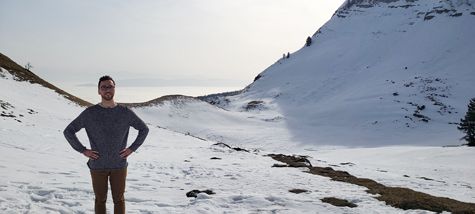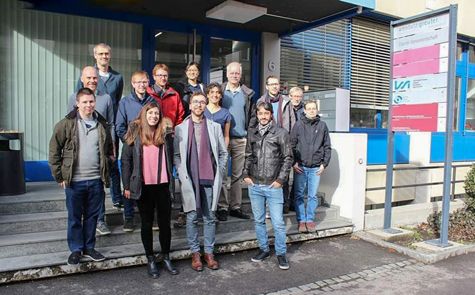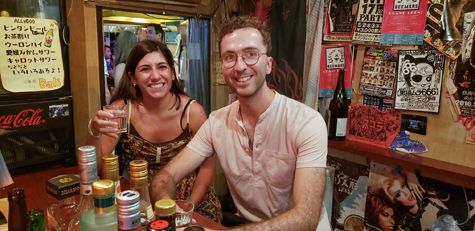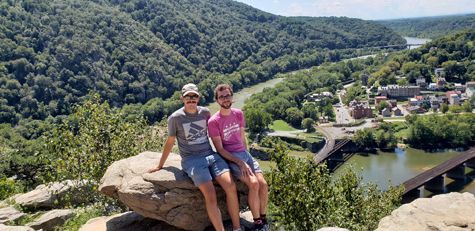Early Career Scientist Spotlight
Dr. Graham Kerr (he/him/his)
Solar Physicist
Heliophysics Science Division (670)
What is your research focus?
Solar flares are transient, yet dramatic, events during which an enormous amount of magnetic energy is liberated (around 10^32 ergs, or tens of billions of nuclear bombs). In the 162 years since the first flare was observed, we have made significant progress in understanding both the energy release and transport processes, but we don’t yet have a full picture. It is particularly important to get this full picture as flares are intimately related to coronal mass ejections (together we refer to these highly energetic phenomenon as solar eruptive events, or SEEs), and so are a fundamental part of geo-effective space weather.
My research focuses on understanding the transport of energy, mass, and radiation through the Sun’s atmosphere during solar flares. In particular, I try to understand how both continuum and spectral line radiation from various neutral species and ions form in two layers of the Sun’s atmosphere, called the chromosphere and the transition region. These layers are where the bulk of the flare energy is deposited, and consequently the site of most of the radiative output during flares. However, they are very complex, partially-ionized plasma environments, making the radiation transport a non-trivial problem and the information carried by the radiation about the conditions in the solar atmosphere difficult to extract. Forward modelling of these regions and examining the properties of the radiation formation are great ways to interpret observations and validate or critique theories of flares.
I simulate how the Sun’s atmosphere responds to solar flares, paying special attention to how radiation (light) moves through the atmosphere. These simulations make predictions about what the light emerging from a flare looks like, which are then compared to observations from NASA missions (mainly the Interface Region Imaging Spectrograph, Hinode/Solar Optical telescope, the Reuven Ramaty High Energy Solar Spectroscopic Imager, and the Solar Dynamics Observatory) or ground based observatories to test how well our theories are able to reproduce what the Sun is actually doing. The places where models fail to stand up to the scrutiny of observations inform us where we are missing some ingredients (some physical processes) in our models.

Credit: Graham Kerr
What motivated you to pursue a career in solar physics?
I was motivated to pursue a career in science initially by a program called the Scottish Space School, which was a Scottish Government program. It allowed any high school physics student to apply to join a ten-day trip to NASA Johnson Space Center (JSC), and I was fortunate enough to be selected. That trip involved meeting with NASA scientists, engineers, and astronauts, as well as doing some science-based activities. Despite being interested in physics and astronomy, I hadn’t really considered studying it after high school as it wasn’t clear how to make a career out of it. In fact, I had previously intended on studying law! So, the Scottish Space School and my visit to NASA JSC were eye-opening experiences. It became clear to me that studying physics at University would open up many varied opportunities and allow me to study something I was passionate about.
Then, the enthusiasm of researchers I interacted with over the course of my studies (undergraduate professors, my PhD advisor Prof Lyndsay Fletcher, and various colleagues too numerous to list) convinced me that I wanted to make research my career. They showed me it was possible to make a career out of studying something I found very interesting.
I also want to point to two mentors who helped me choose solar physics as my field of study. In my third year of undergraduate study, I was selected for a Research Experience for Undergraduates (REU) program in Montana State University’s solar physics group, working with Prof. Jiong Qiu. I applied initially because I wanted some research experience to see if I enjoyed that as a potential career, but I also loved the idea of hiking around Montana for the summer and being able to travel. I didn’t know anything about solar physics prior to that summer and had not really heard about solar flares before. Working with Jiong showed me how many different elements of physics and astronomy come together when studying the Sun and how fun it was to tackle the problem of flares. It was a really engaging and informative experience, and Jiong gave me a wonderful introduction to research, solar flares, and the community of solar physics researchers. While in Montana, I learned that the University of Glasgow (my undergraduate institution) actually had a world-leading solar physics research group, so, when I got back home, I spoke with Prof. Lyndsay Fletcher and worked with her on a final year research project. Working with Lyndsay was great; she is a very supportive and passionate scientist who made the work seem challenging yet fun. It was a very easy choice for me to accept a PhD position with her as my supervisor, starting my career as a solar physicist.

Credit: Graham Kerr
What do you enjoy the most about your job?
It sounds corny, but for a brief time you might be the only person who has ever known something about whatever it is that you are studying, or the only person who has ever made a particular realization. No matter how small that discovery or realization is, it is a neat feeling! I also enjoy sharing those results at conferences and in publications and debating them with colleagues.
What does a typical day at work look like for you?
Today was fairly typical, so I will summarise what I was doing today.
After dealing with some emails and a query from a student I’m working with, I checked on some flare simulations that I started running yesterday. Most were chugging along nicely, but one had crashed overnight. I spent some time identifying the issue, tweaked some parameters, and set it running again.
While I waited for those to complete, I wrote a section for a funding proposal that is due in a couple of weeks and read some related journal articles in preparation for a meeting with the proposal’s principal investigator (PI) tomorrow. I am going to a conference next week, so I worked on my slides for the presentation I am giving, and then I started reading a paper that I am reviewing for a journal.
I am involved in some committees at Goddard Space Flight Center (GSFC). Today I took part in a meeting to flesh out the strategic plan of the LGBT Advisory Committee, and I helped edit a presentation for another committee’s event on Friday.
By the afternoon, the simulations had finished running, so I started to analyse them. For this particular project I am interested how certain spectral lines of Helium respond to flares. Our models can qualitatively reproduce the observation that the line initially gets dimmer in a flare before getting bright, but our predicted timescale of dimming is too short. I am running several experiments to try to understand why this discrepancy exists. The simulation lets me not only analyse the characteristics of the synthetic spectra but also to dig into the formation properties to determine why the line has those characteristics. I spent the rest of the afternoon measuring the timescales and checking what effect the various model set-ups had on those timescales.

Credit: Graham Kerr
What is one research project that you are particularly excited about, and why?
It is hard to choose just one as I’m fortunate to be involved in several really interesting projects at the moment. If I had to single one out, I would choose a project to investigate some unusual behaviour exhibited by helium during solar flares. Observations have recently shown that instead of getting brighter, like the rest of solar emission during a flare, a spectral line emitted by helium in the infrared (IR), at 1083nm, counterintuitively initially gets dimmer. This period of dimming lasts for a few dozen seconds before it gets brighter. I have been working with the observers to try to understand what is going by simulating the response of helium during flares. We have shown that this dimming effect is due to the way flare-accelerated electrons interact with helium, and that the character of the dimming can carry some important information about flare energy transport. However, our models predict only a short duration of dimming compared to the several dozens of seconds observed. So, we are now working to address this discrepancy, learn what implications the duration of this unusual dimming means for flares, and to figure out how to extract new diagnostics from this spectral line.
Are you involved in any upcoming space missions?
I am not directly involved in any upcoming space missions, but I have been involved in a past mission concept (that was unfortunately not selected) and am on the science team for a mission that is currently undergoing a Phase A concept study (fingers crossed for selection next spring!). Before joining GSFC, I had not been involved in any mission concepts or proposals, so it has been a very interesting experience being a Co-Investigator on a proposal, and now on the science team for a concept study. Seeing the process of bringing a mission proposal to life from an initial idea and set of science questions to a fleshed-out design was really neat. I’m really grateful to the mission PIs for involving me in those proposals, and seeing how they managed the projects has been rewarding and informative. It really makes you appreciate the sheer amount of work that goes into launching and running a mission!

Credit: Graham Kerr
What do you like to do in your free time?
During non-Covid times I loved to travel, which has been unfortunately curtailed recently. I also enjoy rock climbing, which I try to do once or twice a week.

Credit: Graham Kerr
Biography
Home Town:
East Kilbride, Scotland
Undergraduate Degree:
MSci (Hons.) Astronomy and Physics, University of Glasgow, Glasgow, Scotland
Post-graduate Degrees:
PhD Astrophysics, University of Glasgow, Glasgow, Scotland

